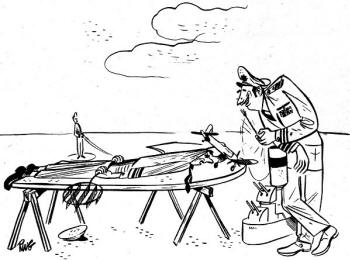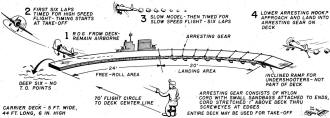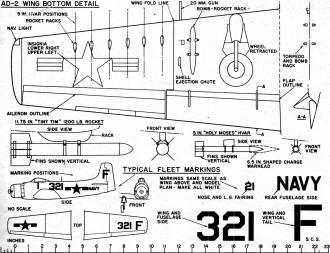|
Control line carrier is a sport that you might think
shouldn't be to hard to master, that is until you watch someone trying to land a model, hanging on the
prop, on the carrier deck. There are plenty of YouTube videos of people doing just that; check a few
out to see what I mean. Although I have never attempted it myself, it is easy to believe that trying
to control the model at near zero forward airspeed - maybe even backwards in a stiff headwind - with
no centrifugal force to keep the lines tight and the model waving in the gusts is not an easy job. Add
to that the coordination needed to establish the hovering attitude in the first place, with a combination
of feeding in a high throttle setting while pulling the nose up to about a 60-degree angle. Then of
course there is the non-trivial task of snagging an arrestor line on the mock carrier deck. But wait,
there's more, as the old Ronco commercial would say. Even if you are a master at the landing, to be
competitive your carrier model must also be able to attain both a very slow speed flying around the
circle and a very high speed going around the circle as part of the competition scoring process. To
make things even more challenging, the design rules are very strict regarding choosing a full-size aircraft
as the scale subject, size, weight, and engine selection. It is indeed not for the faint-of-heart.
See "Portable
Control Line Aircraft Carrier Deck" (March 1962 American Modeler), "Livingston
(NJ) Club Builds Carrier Deck" (September 1967 American Modeler), and "Flying the Carrier Event"
(July 1951 Air Trails).
Flying the Carrier Event
Here's what every contestant should know about selecting a model and engine for the Navy's event
as told by the 1950 winner
By S. Calhoun Smith

"It's the model that hits the deck, Perkins
Most of the scale details that can be added to the Skyraider model presented last month are on the
underside of the wings. Here is the firepower department, and although accurate details are unobtainable
we've done the best we can with the many photos on hand.
There are numerous combinations of "bad news" that can be carried, such as: twelve 5" or 6.5" rockets
or light bombs and three 150 gal. drop tanks for very long range operation. With a single 150 gal. drop
tank the. AD can carry two 11.75" Tiny Tim rockets or two 2000 lb. bombs. For short range missions the
load can be three 2000 lb. bombs. Also three 1000 lb. bombs or two Tiny Tims and one 21" 2000 lb. torpedo,
or two Tiny Tims and one 1000 lb. bomb and twelve 5" rockets. Throw in some Napalm and anti-personnel
frag bombs-anything up to 6000 lbs. and - why, it's enough to scare the wits out of you.
Shown on the plans are details of the bomb and rocket racks and outlines for the Tiny Tim, 5" and
6.5" shaped charge rockets. These can be made of' birch dowel if you want to carry the extra weight,
or can be carved from balsa. The rockets will make an impressive display in any flying scale or beauty
event.
Fleet marking letter and numeral combinations are also shown on the plan, and to further confuse
the enemy we are not giving the right names. Letters and numerals are all white. Some squadrons have
bright color bands around cowl front and across fin and rudder top. These can be added to further dress
up your model. Pilot and squadron insignias are also carried on fuselage sides, below cockpit. Trim-Film
decal sheets can be used for all these markings.
Thanks to the effort of Lt. John H. Burton, the first Navy Carrier Event was held at the 1950 Nationals.
The rules governing the competition were briefly as follows:

Sketch of control line carrier flight sequence.
Any type. model is eligible, scale models. of existing naval aircraft may be to any scale, the only
restriction being maximum size, 44" span, 58" length and 17" height. Models must have a conventional
(fixed or retractable) landing gear and any engine may be used.
The model must R.O.G. from the simulated carrier deck and stay airborne. One hundred points given
for successful take-off. The first six laps after take-off will be timed for high-speed flight. One
point for each mph average speed.
When model is slowed down the next six laps are timed for slow-speed flight. The difference between
high and low speeds is added to the high speed points to get total speed points possible.
An arresting hook shall be provided on the model for landing into the gear on the carrier deck. One
hundred points will be awarded for a successful arrested landing with the model on the deck and in any
position except over on its back.
Bonus points (100) will be awarded for true scale replica of any U. S. military aircraft.
Total points will be sum of take-off, high speed, low speed, landing and bonus points gained in one
flight.
Five minutes allowed for preparation and three attempts permitted.
Sounds tough to beat, doesn't it? In designing for the 1950 event the first item needed was 2-speed
control. We fell back on the tried and true ignition O&R 60 with 2-speed points running on gas and
oil fuel. This eased starting and flight problems when used with Jim Walker's Remoto control handle.
It was felt that the emphasis should be on the slow speed rather than the high so that a decent landing
could be made without scattering arresting gear and tail feathers all over the deck. As a result, top
speed was only 56 mph, and low speed 43 mph. Recent developments such as Deco's glow plug 2-speed throttle
will spread out the difference between high and low speeds for the coming 1951 contest.
Some modelers have experimented with the variable-pitch propeller. Here is one gadget that would
really aid high and low speed flight performance. The problems are pretty complicated but not insurmountable.
Various schemes were tried at the 1950 contest for slowing down the models. Third-line-operated chokes
on glow plug engines, trailing parachutes and wing flaps released by timers, turned up. None of the
systems proved completely successful, indicating there is room for development in this department.
We built operating wing flaps into the Skyraider, but test flights did not prove very successful.
There was too much trim change with flaps down to be fully controlled by the elevators. The flaps were
spring loaded into the down position, and the model developed beautiful roll tendencies when one flap
or the other was blown up by gusts and prop wash. Next time we plan to use bigger springs.
If a modeler cared to tinker a bit he could possibly work out a system that changed the incidence
of the stabilizer to compensate for the nose-heavy trim with the flaps down. Drag flaps or spoilers
would seem to be the best bet for slowing a model. The dive flaps on the prototype Skyraider opening
from the fuselage sides and bottom might do the job. These are used for dive bombing and not for landing,
so there would be some departure from realism.
The trailing parachute idea could be worked out with a bit of experimenting to find the right size
parachute for a particular model. The chute should be vented at the top like a real chute, or better
Still could be similar to the new ribbon type used for high speed bailout and bomber braking. The chute
need not be as complicated as the big ribbon chutes, but could simply have a number of vent holes around
the canopy.
On the AD-2 both wing flaps and arresting hook were lowered by timer action. An old-fashioned photo
timer was employed because it had a good strong pull near the end of its travel. The tuner pulled a
wire which released the hook, the system being similar to that used for free-flight pop-up de-thermalizers.
The hook was timed to drop after one minute, which gave ample time for take-off and six high-speed laps.
Any type timer could be used, such as the Spitfire fuel cut-off with a little modification.
It was decided to build at the top of the class, so to speak. The Carrier Event was flown on 70 ft.
lines so a big model and a big engine were chosen. We didn't watch the weight too carefully because
we wanted a fairly heavy model that would slow down quickly. This meant better control for the spot
landing required. Lighter models have a tendency to float too far and fast. The answer would seem to
be high power and fair lifting qualities to carry a heavy model. You can't have everything, though.
A light model will fly fast but will float like crazy. A heavy model will not fly fast but will slow
down quickly. Somewhere in there is the happy medium, plenty of power for fast flight and low power
that will just hang the model on the prop until the time comes to drop it in.
The model doesn't have to be a big brick, however. The exhibition Carrier Event flown at the Plymouth
Internationals featured smaller airplanes using O&R 23-29 engines with 2-speed ignition. These smaller
models were mostly about three-foot wingspan and were stunt jobs that some of the boys had noodled up
with semi-scale Hellcat and Bearcat fuselages.
In the scale category the most suitable types include all the prop-driven carrier-based Navy ships.
The general design characteristics of the big prototypes are exactly what's needed when scaled down
for model flying. The list is long. First of all the SNJ trainer, the Grumman F6F & F8F ("Cat" series),
the new Martin Mauler AM-1 and Grumman AF-2, ever faithful F4U Corsair and some of the older bombers,
Avenger, Dauntless and Curtiss SB2C could be used. And for those with nostalgia in their veins, don't
forget the old Hawks and Boeing F4B4 biplanes. The biplanes are even better suited to the model carrier
event than the low wings. Their landing characteristics are just what the doctor ordered.
When some bright modeler figures out how to throttle down the Dyna-Jet, look out for the Panthers
and Banshees. These will win the event hands down.
If you really want to get fancy, why not a twin-engine ship? The Tigercat F7F and the newer North
American AJ-1 are two noteworthy types.
We-believe that model design features should follow these rules of thumb more or less for successful
performance. Size should be 3 ft. span up to maximum allowable 44". (This can be the wingspan when folded.)
Flying on 70 ft. lines in gusty weather at different speeds can get hairy with smaller models. It can
be done, yes, but the degree of precision required won't let you wander around the center of the circle
during a landing. Your handle has to be right over the center of the circle to put the ship on the deck.
Remember it's only five feet wide. One normal walking step either side of the spot and your ship goes
in the drink.
Powerplants can be from .20 on up to .60 depending on model size. Some gadget for 2-speed, multiple
speed or throttle choke is a must.
Since no stunt flying is to be done, models can have lifting airfoils instead of symmetrical stunt
airfoils. Fairly thick 10-15% sections can be used since good take-off qualities are needed. Scale or
semi-scale biplanes, high, mid and low wings are all suitable providing balance is right. Your model
will have to be trimmed right for this event. If she's nose heavy, she won't get off soon enough and
glide will be fast. If it's tail heavy - but we don't have to talk about that!
Some method for slowing down in addition to engine control would be desirable and helpful.
Of course an arresting hook must be built onto the model. It can either be dropped into landing position
by a timer after the flight is under way or can be left dangling from the take-off. If the hook is to
simply hang, the open end should be doubled back on itself so that it won't catch on the deck. The hook
should be firmly mounted in the model since it will take some hard wallops. Size of hook should not
be too small. For instance, we used 3/32" dia. steel wire for the 3 1/2 lb. Sky raider. The hook did
not bend or deform in the landing.
Actually the Carrier Event requires a more realistic type of model flying than any other contest
event. Take a scale model and make it do a job like its prototype, and brother. you've accomplished
a lot. Wait till they start landing on a 44 ft. carrier deck with R-C models!

Control Line Carrier AD-2 Plans
Posted January 17, 2015
|





